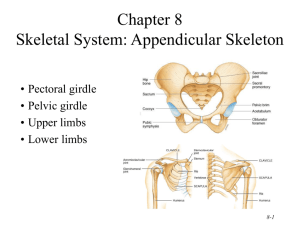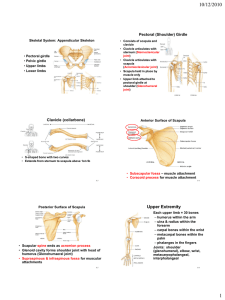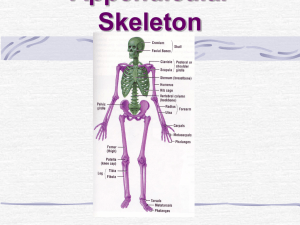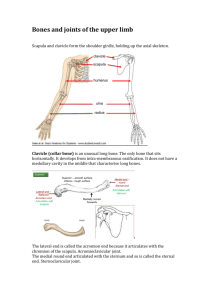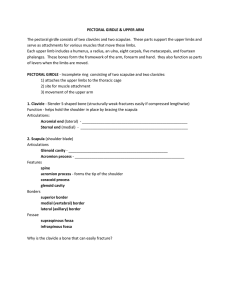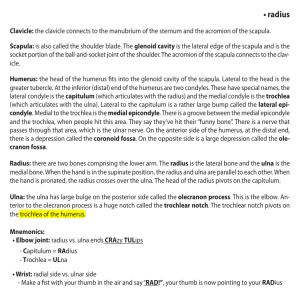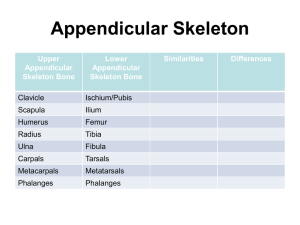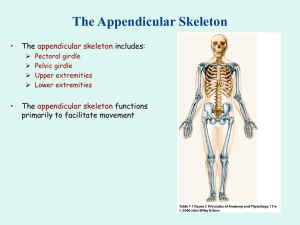8-1
advertisement
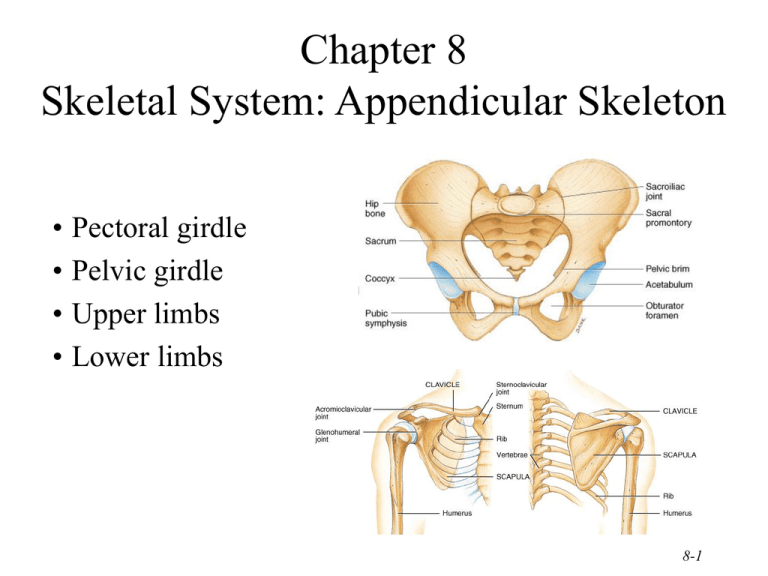
Chapter 8 Skeletal System: Appendicular Skeleton • Pectoral girdle • Pelvic girdle • Upper limbs • Lower limbs 8-1 Pectoral (Shoulder) Girdle • • • • • Consists of scapula and clavicle Clavicle articulates with sternum (sternoclavicular joint) Clavicle articulates with scapula (acromioclavicular joint) Scapula held in place by muscle only Upper limb attached to pectoral girdle at shoulder (glenohumeral joint) 8-2 Clavicle (collarbone) • S-shaped bone with two curves – medial curve convex anteriorly/lateral one concave anteriorly • Extends from sternum to scapula above 1st rib • Fracture site is junction of curves • Ligaments attached to clavicle stabilize its position. 8-3 Anterior Surface of Scapula • Subscapular fossa filled with muscle • Coracoid process for muscle attachment 8-4 Posterior Surface of Scapula • Triangular flat bone found in upper back region • Scapular spine ends as acromion process – a sharp ridge widening to a flat process • Glenoid cavity forms shoulder joint with head of humerus • Supraspinous & infraspinous fossa for muscular attachments 8-5 Upper Extremity • Each upper limb = 30 bones – – – – – humerus within the arm ulna & radius within the forearm carpal bones within the wrist metacarpal bones within the palm phalanges in the fingers • Joints – shoulder (glenohumeral), elbow, wrist, metacarpophalangeal, interphalangeal 8-6 Humerus --- Proximal End • Part of shoulder joint • Head & anatomical neck • Greater & lesser tubercles for muscle attachments • Intertubercular sulcus or bicipital groove • Surgical neck is fracture site • Deltoid tuberosity • Shaft 8-7 Humerus --- Distal End • Forms elbow joint with ulna and radius • Capitulum – articulates with head of radius • Trochlea – articulation with ulna • Olecranon fossa – posterior depression for olecranon process of ulna • Medial & lateral epicondyles – attachment of forearm muscles 8-8 Ulna & Radius --- Proximal End • Ulna (on little finger side) – trochlear notch articulates with humerus & radial notch with radius – olecranon process forms point of elbow • Radius (on thumb side) – head articulates with capitulum of humerus & radial notch of ulna – tuberosity for muscle attachment 8-9 Elbow Joint • • • • Articulation of humerus with ulna and radius Ulna articulates with trochlea of humerus Radius articulates with capitulum of humerus Interosseous membrane between ulna & radius provides site for muscle attachment 8-10 Ulna and Radius - Distal End • Ulna --styloid process – head separated from wrist joint by fibrocartilage disc • Radius – forms wrist joint with scaphoid, lunate & triquetrum – forms distal radioulnar joint with head of ulna 8-11 8 Carpal Bones (wrist) • Proximal row - lat to med – scaphoid - boat shaped – lunate - moon shaped – triquetrum - 3 corners – pisiform - pea shaped • Distal row - lateral to medial – trapezium - four sided – trapezoid - four sided – capitate - large head – hamate - hooked process • Carpal tunnel--tunnel of bone & flexor retinaculum 8-12 Metacarpals and Phalanges • Metacarpals – 5 total----#1 proximal to thumb – base, shaft, head – knuckles (metacarpophalangeal joints) • Phalanges – 14 total: each is called phalanx – proximal, middle, distal on each finger, except thumb – base, shaft, head 8-13 Pelvic Girdle and Hip Bones • Pelvic girdle = two hipbones united at pubic symphysis – articulate posteriorly with sacrum at sacroiliac joints • Each hip bone = ilium, pubis, and ischium – fuse after birth at acetabulum • Bony pelvis = 2 hip bones, sacrum and coccyx 8-14 Ischium and Pubis • Ischium – ischial spine & tuberosity – lesser sciatic notch – ramus • Pubis – body – superior & inferior ramus – pubic symphysis is pad of fibrocartilage between 2 pubic bones 8-15 Ilium • • • • • Iliac crest and iliac spines for muscle attachment Iliac fossa for muscle attachment Gluteal lines indicating muscle attachment Sacroiliac joint at auricular surface & iliac tuberosity Greater sciatic notch for sciatic nerve 8-16 Pelvis • Pelvis = sacrum, coccyx & 2 hip bones • Pelvic brim – sacral promontory to symphysis pubis – separates false from true pelvis – false pelvis holds only abdominal organs • Inlet & outlet • Pelvic axis = path of babies head 8-17 Female and Male Skeletons • Male skeleton – larger and heavier – larger articular surfaces – larger muscle attachments • Female pelvis – wider & shallower – larger pelvic inlet & outlet – more space in true pelvis – pubic arch >90 degrees 8-18 Female Male 8-19 Lower Extremity • Each lower limb = 30 bones – – – – – femur and patella within the thigh tibia & fibula within the leg tarsal bones in the foot metatarsals within the forefoot phalanges in the toes • Joints – hip, knee, ankle – proximal & distal tibiofibular – metatarsophalangeal 8-20 Femur and Patella • Femur (thighbone) – longest & strongest bone in body – head articulates with acetabulum (attached by ligament of head of femur) – neck is common fracture site – greater & lesser trochanters, linea aspera, & gluteal tuberosity-- muscle attachments – medial & lateral condyles articulate with tibia – patellar surface anteriorly between condyles 8-21 Patella triangular sesamoid increases leverage of quadriceps femoris tendon 8-22 Tibia and Fibula • Tibia – medial & larger bone of leg – weight-bearing bone – lateral & medial condyles – tibial tuberosity for patellar lig. – proximal tibiofibular joint – medial malleolus at ankle • Fibula – not part of knee joint – muscle attachment only – lateral malleolus at ankle 8-23 Tarsus • Proximal region of foot (contains 7 tarsal bones) • Talus = ankle bone (articulates with tibia & fibula) • Calcaneus - heel bone • Cuboid, navicular & 3 cuneiforms 8-24 Metatarsus and Phalanges • Metatarsus – midregion of the foot – 5 metatarsals (1 is most medial) – each with base, shaft and head • Phalanges – distal portion of the foot – similar in number and arrangement to the 8-25 Arches of the Foot • Function – distribute body weight over foot – yield & spring back when weight is lifted • Longitudinal arches along each side of foot • Transverse arch across midfoot region – navicular, cuneiforms & bases of metatarsals 8-26 Clinical Problems • Flatfoot – weakened ligaments allow bones of medial arch to drop • Clawfoot – medial arch is too elevated 8-27 Development of the skeletal system 8-28
